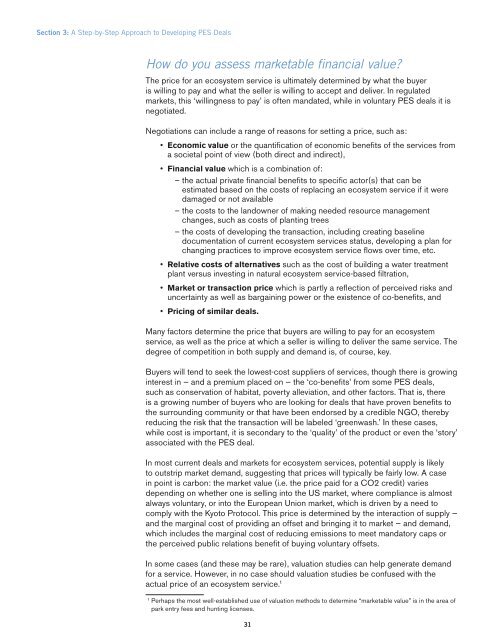Payments for Ecosystem Services: Getting Started. A Primer - UNEP
Payments for Ecosystem Services: Getting Started. A Primer - UNEP
Payments for Ecosystem Services: Getting Started. A Primer - UNEP
Create successful ePaper yourself
Turn your PDF publications into a flip-book with our unique Google optimized e-Paper software.
Section 3: A Step-by-Step Approach to Developing PES Deals<br />
How do you assess marketable financial value?<br />
The price <strong>for</strong> an ecosystem service is ultimately determined by what the buyer<br />
is willing to pay and what the seller is willing to accept and deliver. In regulated<br />
markets, this ‘willingness to pay’ is often mandated, while in voluntary PES deals it is<br />
negotiated.<br />
Negotiations can include a range of reasons <strong>for</strong> setting a price, such as:<br />
• Economic value or the quantifi cation of economic benefi ts of the services from<br />
a societal point of view (both direct and indirect),<br />
• Financial value which is a combination of:<br />
– the actual private fi nancial benefi ts to specifi c actor(s) that can be<br />
estimated based on the costs of replacing an ecosystem service if it were<br />
damaged or not available<br />
– the costs to the landowner of making needed resource management<br />
changes, such as costs of planting trees<br />
– the costs of developing the transaction, including creating baseline<br />
documentation of current ecosystem services status, developing a plan <strong>for</strong><br />
changing practices to improve ecosystem service fl ows over time, etc.<br />
• Relative costs of alternatives such as the cost of building a water treatment<br />
plant versus investing in natural ecosystem service-based fi ltration,<br />
• Market or transaction price which is partly a refl ection of perceived risks and<br />
uncertainty as well as bargaining power or the existence of co-benefi ts, and<br />
• Pricing of similar deals.<br />
Many factors determine the price that buyers are willing to pay <strong>for</strong> an ecosystem<br />
service, as well as the price at which a seller is willing to deliver the same service. The<br />
degree of competition in both supply and demand is, of course, key.<br />
Buyers will tend to seek the lowest-cost suppliers of services, though there is growing<br />
interest in — and a premium placed on — the ‘co-benefi ts’ from some PES deals,<br />
such as conservation of habitat, poverty alleviation, and other factors. That is, there<br />
is a growing number of buyers who are looking <strong>for</strong> deals that have proven benefi ts to<br />
the surrounding community or that have been endorsed by a credible NGO, thereby<br />
reducing the risk that the transaction will be labeled ‘greenwash.’ In these cases,<br />
while cost is important, it is secondary to the ‘quality’ of the product or even the ‘story’<br />
associated with the PES deal.<br />
In most current deals and markets <strong>for</strong> ecosystem services, potential supply is likely<br />
to outstrip market demand, suggesting that prices will typically be fairly low. A case<br />
in point is carbon: the market value (i.e. the price paid <strong>for</strong> a CO2 credit) varies<br />
depending on whether one is selling into the US market, where compliance is almost<br />
always voluntary, or into the European Union market, which is driven by a need to<br />
comply with the Kyoto Protocol. This price is determined by the interaction of supply —<br />
and the marginal cost of providing an offset and bringing it to market — and demand,<br />
which includes the marginal cost of reducing emissions to meet mandatory caps or<br />
the perceived public relations benefi t of buying voluntary offsets.<br />
In some cases (and these may be rare), valuation studies can help generate demand<br />
<strong>for</strong> a service. However, in no case should valuation studies be confused with the<br />
actual price of an ecosystem service. 1<br />
1<br />
Perhaps the most well-established use of valuation methods to determine “marketable value” is in the area of<br />
park entry fees and hunting licenses.<br />
31
















